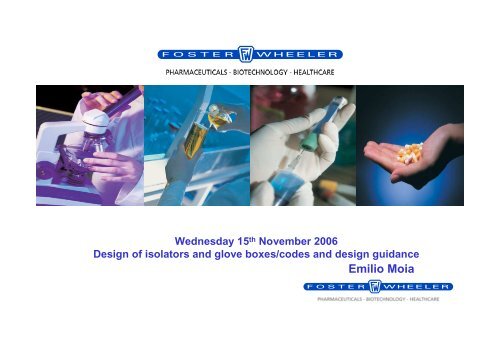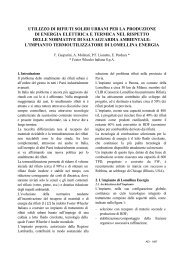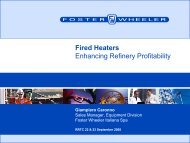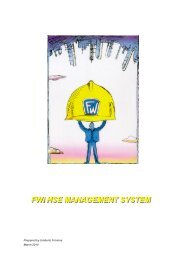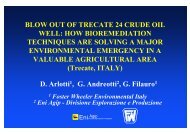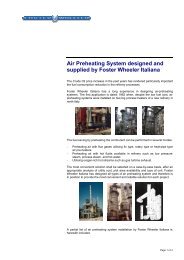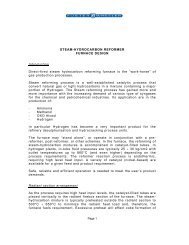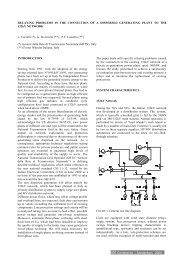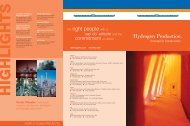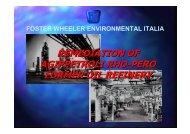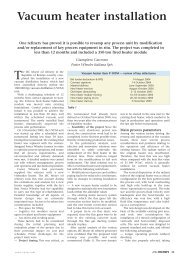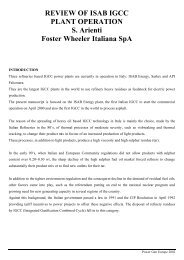ISO 14644-7 Transfer Devices - Foster Wheeler Italiana
ISO 14644-7 Transfer Devices - Foster Wheeler Italiana
ISO 14644-7 Transfer Devices - Foster Wheeler Italiana
You also want an ePaper? Increase the reach of your titles
YUMPU automatically turns print PDFs into web optimized ePapers that Google loves.
Wednesday 15 th November 2006Design of isolators and glove boxes/codes and design guidanceEmilio Moia
Contents1. Introduction2. Development of isolator concept3. Containment Isolator Standard4. Containment Isolator Design Criteria5. Testing6. Example of isolator2
Contents1. Introduction2. Development of isolator concept3. Containment Isolator Standard4. Containment Isolator Design Criteria5. Testing6. Example of isolator3
The Isolation continuum4
Block flow diagram for development of isolatorDetermineworker ExposureLimitReview processoperationIdentifyoperation thatrequirecontainmentSelect conceptfor designDevelop conceptsfor isolators thatperformoperationsPreliminarydesign drawingBuild Mock-upFinal Designbased on mockupchanges5
Contents1. Introduction2. Development of isolator concept3. Containment Isolator Standard4. Containment Isolator Design Criteria5. Testing6. Example of isolator6
Identification of operation that require containment7
Concepts of isolator that perform operationsMaterial inManipulationCleaningExtraction ofmaterial throughplasticbagorthrough the RTPport8
Detail of material exhaust9
Select concept for designRaw MaterialIBCSubstanceOEL µg/m 3H-GroupCharacteristicpolvereQuantity>1 KgTime (Short:< 30') ----Control StrategyXXX1DLMLongCS4BLENDEROperation descriptionFilter dryer dischargeIBCFILTERDRYERTabletpackingIBCsubstanceOEL µg/m 3H-Groupcharacteristicpolverequanity>1 Kgtime (Short:< 30') ----Control StrategyXXX1DLMLongCS 3Operation descriptionTabletting10
Select concept for designRaw MaterialIBCBLENDERIBCFILTERDRYERContainment Isolatorwith RPTabletpackingRABSIBC11
Isolator for dispensing: U.R.Exhaust fanSingle push pushfilter with flapDouble push pushfilter with flapChamberFull size door alwaysopen during “production”BatteryLimitsDoorBattery LimitsInterlockeddoorsWeighingscaleBIN liftBINZANCHETTA<strong>ISO</strong> valveThermobalancefor LODtestingTappeddensitytesterParticle sizedistributionequipment12
Isolator for dispensing: U.R.Pre.chamberInterlockeddoorsElectrical supplyfor weighing scaleElectrical supply and printsignal for thermo-balancefor LOD testingFull size door alwaysopen during “production”Electrical supplyfor tapped densitytesterElectrical supplyfor particle sizedistributionequipmentDoorWaste continuousfilm bagging andsealing systemHot waterCold waterBatteryLimitsDistribution pipingfor hot/cold waterto spray gunsWeighingscaleConnection forhot/cold watersupply to spraygunsConnectionto BINChamberThermobalancefor LODtestingTappeddensitytesterParticle sizedistributionequipment13
USERREQUIREMENTIsolator Design CycleDetailDesignMock-upTestingPreliminaryDesignFAT & SATIQ & OQIsolator design cycleRealization &installation14
Contents1. Introduction2. Development of isolator concept3. Containment Isolator Standard4. Containment Isolator Design Criteria5. Testing6. Example of isolator15
Containment Isolator Standard• <strong>ISO</strong> <strong>14644</strong>-7: Separative devices (clean air hoods, gloveboxes, isolators andminienvironments)• <strong>ISO</strong> 10648-1, Containment enclosures — Part 1: Design principles• <strong>ISO</strong> 10648-2, Containment enclosures — Part 2: Classification according to leak tightness andassociated checking method• AGS-G001-1998• EN 12469, Biotechnology — Performance criteria for microbiological safety cabinets16
<strong>ISO</strong> <strong>14644</strong>-7• 1 Scope• 2 Normative references• 3 Terms and definitions• 4 Specification of requirements• 5 Design and construction• 6 Access <strong>Devices</strong>• 7 <strong>Transfer</strong> <strong>Devices</strong>• 8 Siting and Installing• 9 Testing and Approval• Annex A (informative) Separation continuum concept• Annex B (informative) Air handling and gas systems• Annex C (informative) Access devices• Annex D (informative) <strong>Transfer</strong> device examples• Annex E (informative) Leak testing• Annex F (informative) Parjo leak test method• Bibliography17
<strong>ISO</strong> <strong>14644</strong>-7: Terms and Definitions• access device: device for manipulation of processes, tools or products within theseparative device• action level:level set by the user in the context of controlled environments, whenexceeded immediate follow-up is required as well as investigation with subsequentcorrective action• alert level :level set by the user for controlled environments giving early warning ofa potential drift from normal conditions, when exceeded an investigation is requiredto ensure that the process and environment are under control.• breach velocity :velocity through an aperture sufficient to prevent movement ofmatter in the opposite direction to the flow• containment :state achieved by separative devices with high degree of separationbetween operator and operation• leak (of separative devices) :defect revealed by testing under a pressure differentialafter corrections for atmospheric conditions• pressure integrity :capability to provide a quantifiable pressure leakage raterepeatable under test conditions• separative device :equipment utilizing constructional and dynamic means to createassured levels of separation between the inside and outside of a defined volume18
<strong>ISO</strong> <strong>14644</strong>-7: RequirementsThe following information shall be defined, agreed and documented between customerand supplier:• reliability and availability;• when appropriate, any applicable hazard analysis• if devices depend on differential pressure, the differential pressure shall becontinuously monitored and alarmed in some applications;• where appropriate, a specified hourly leak rate (for an example of methodology, seeAnnex E);• other operational parameters, including 1) test points,2) alert and action levels to bemeasured to ensure compliance,3) test methods;• required methods of measurement, sample locations, control, monitoring anddocumentation;• mode of entry or exit of separative devices and related equipment, apparatus,supplies and personnel into• the controlled environment required during 1) installation, 2) commissioning, 3)operation, 4) maintenance;19
<strong>ISO</strong> <strong>14644</strong>-7: Requirements• layout and configuration of the installation;• critical dimensions and mass restrictions, including those related to available space;• process requirements that affect the installation;• process equipment list with utility requirements;• maintenance requirements of the installation;• responsibilities for the preparation, approval, execution, supervision,documentation, statement of criteria, basis of design, construction, testing, training,commissioning and qualification, including performance, witnessing, and reportingof tests;• identification and assessment of external environmental influencidentification and assessment of external environmental influences es;• compliance with local regulations.20
<strong>ISO</strong> <strong>14644</strong>-7: Design and Construction• Separative-device design shall provide the process, the operator or third party withprotection against contamination appropriate to the operation being performed.• Consideration shall be given to malfunction, procedures and ancillary systemsinvolved with the separative-device application (see Annex B).• Consideration shall be given to access devices and transfer devices (see Annexes Cand D).• Separative devices shall be ergonomically designed for easy access to all internalsurfaces and work: areas, and with respect to the process undertaken.• Access devices shall be of the minimum size and number consistent with operation,cleaning and maintenance.• Consideration shall be given to differential operating pressure, including excursions.• External influences, such as air flow, vibration and pressure differences, shall beconsidered to avoid adverse effects on integrity and function.• Provision for cleaning or decontamination, including possible disposal of the deviceor its components, shall form part of the design criteria.21
<strong>ISO</strong> <strong>14644</strong>-7: Design and Construction• Built-in test facilities and appropriate alarms shall be included.• <strong>Transfer</strong> device(s) shall be appropriate to process and routine operation.• Filtration shall be appropriate for application.• Whenever possible, items requiring maintenance shall be external to the separativedevice.• Materials used in the construction of separative devices, including sealing materials,fans, ventilation systems, piping and associated fittings, shall be chemically andmechanically compatible with the intended processes, process materials, applicationand decontamination methods. Protection against corrosion and degradation duringprolonged use shall be considered. Heat and fire resistant construction materialsshall be considered when appropriate (see Annex B). Where appropriate, materialsused shall be checked for thermal characteristics, sorption and out gassingproperties. Materials selected for viewing panels shall be tested and proven toremain transparent and resistant to changes that would prevent clear visibility.22
<strong>ISO</strong> <strong>14644</strong>-7 Access <strong>Devices</strong>• Gauntlets, glove systems, half-suits• When using gauntlets, glove systems and half-suits, these types of flexible-membraneaccess device systems shall be designed and constructed to allow for glove changewithout breaching the separative device (see Annex C). These systems are unlikely tomaintain molecular containment, therefore alternative systems should be considered forapplications requiring molecular containment.• Glove ports and glove cuff rings devices shall be designed for ease eof change, integritytesting and security of operation.• The following selection criteria shall be considered in choosing gauntlet, glove sleeveand halfsuit system materials that are vital in maintaining separation:• a) materials and tools to be handled within the separative device;• b) temperature limitations of the glove materials;• c) acceptable permeability;• d) chemical resistance or mechanical strength, or both;• e) sorption and desorption of chemicals;• f) known shelf and service lives of glove material;• g) differential pressures, including transient excursions (operating and abnormalpressures);• h) operations to be performed.23
<strong>ISO</strong> <strong>14644</strong>-7 Access <strong>Devices</strong> – Glove Materiala) Latex, natural rubber or cis-1,4-polyisoprene• Latex, natural rubber or cis-1,4-polyisoprene is suitable in cases where great flexibility and goodmechanical properties are necessary. However, latex articles are not impermeable to gas, perishin ozone, offer no resistance to flame, hydrocarbons and oxidising salts and poor resistance toesters, acids and bases. The potential of life-threatening allergic reactions should be considered.b) Polychloroprene or 2-chloro-1,3-butadiene• Polychloroprene or 2-chloro-1,3-butadiene is especially recommended when good resistance tooils and greases is needed. This chloroprene is self extinguishing, i.e. when the source of ignitionis removed it no longer continues to burn. Polychloroprene is highly resistant to ozone, ultravioletlight, concentrated acids and bases, and strong oxidising agents. Polychloroprene articles areunsuitable for work with hydrocarbons, halogens and esters.c) Nitrile or copolymer of butadiene and acrylonitrile• Nitrile or copolymer of butadiene and acrylonitrile is recommended when good resistance tosolvents is required. Nitrile articles stand up well to aliphatic hydrocarbons and hydroxylcompounds.d) Polyvinyl chloride• Although plastic, polyvinyl chloride has a certain elasticity and is recommended for its goodelectrical properties and resistance to chemical agents.e) Chlorosulfonated polyethylene• Chlorosulfonated polyethylene offers very good resistance to H2O2, and its white colour allowsgood visual inspection. Other materials are resistant to H2O2, as well.24
<strong>ISO</strong> <strong>14644</strong>-7 <strong>Transfer</strong> <strong>Devices</strong>• <strong>Transfer</strong> devices• Use :<strong>Transfer</strong> devices shall not diminish the performance of separative devices. Inspecific applications, transfer devices become critical in maintaining integrity of thedevice or process. Some transfer devices are used as independent separative devices.• Selection :Selection of a transfer device shall be based on the level of separationrequired by the application. The hourly leak rate of the transfer device shall not begreater than the hourly leak rate of the separative device which the transfer deviceserves. <strong>Transfer</strong> devices shall minimize the transfer of unwanted matter. Outlinediagrams and descriptions of possible types of transfer device are included in AnnexD. These diagrams are only illustrative examples of possible configurations.• Fail-safe design :In the event of power failure, transfer devices that have electricalinterlocking mechanisms shall prevent access via the transfer devicevice.25
<strong>ISO</strong> <strong>14644</strong>-7 Testing and ApprovalGlove breach test:• When appropriate, the airflow through one open glove port shall be measured by placing ananemometer at the centre of the glove port. The velocity shall be agreed between customer andsupplier (guidance value: 0,5 m/s).Leak testing• When appropriate, a leak test shall be performed. Guidance is given in Annexes E and F.– NOTE Integrity testing on some separative devices that operate close to atmospherepressure (less than 1 000 Pa) requires detailed procedures and sensitive test equipment toestablish a quantifiable leak rate. The resulting leak determines acceptability for theintended application (see Annex A).• When appropriate, an induction leak test shall be performed. Guidance is given in Annex E.– NOTE Induction leaks can occur when the velocity across an orifice creates a pressuredepression and induces a reverse flow through the orifice (Venturi effect). <strong>Devices</strong> thatoperate at low differential pressures may be compromised by induction leakage.Similarly, devices that utilise over pressure or flow to minimise or prevent the transfer ofunwanted matter may be at risk from induction leakage when operating under transientvolume changes such as glove entry or withdrawal.26
<strong>ISO</strong> <strong>14644</strong>-7 Testing and ApprovalPeriodic testing• The tests and checks are a function of the application and instrumentation/detection systems. Routinetests shall be established and recorded for comparison preventative maintenance requirements.• The following recommendations for testing are given:– a) half-suit/glove testing– 1) on commissioning,– 2) prior to and after completion of work,– 3) after glove/glove sleeve changes;– b) pressure testing– 1) on commissioning,– 2) after any airflow or filter-pressure parameter changes,– 3) after maintenance affecting the separative device envelope or pressure control devices;– c) induction testing on commissioning;– d) instrumentation and alarm system testing– 1) on commissioning,– 2) after maintenance affecting the control system,– 3) at the frequency dictated by the instrumentation manufacturer,– 4) at predetermined periods consistent with use and operational requirements.27
<strong>ISO</strong> <strong>14644</strong>-7 Annex DA1 transfer device• When operated in accordance with a validated transfer procedure, air can flow freely throughthe A1 transfer device (see Figure D.1) between the background environment and theseparative-device environment when the door is open.• EXAMPLES Doors, access panels, zips, hook and loop tape, poppers and “jam pot”covers, bag-in-bag-out.1 separative-device environment2 background environment3 ingress4 egress5 sealed door6 work surface of controlled workspaceFigure D.1 — A1 transfer device28
<strong>ISO</strong> <strong>14644</strong>-7 Annex DA2 transfer device• When operated in accordance with a validated transfer procedure in a dynamic state, air flowsfreely through the A2 transfer device (see Figure D.2) out of the separative deviceenvironment.• EXAMPLES Dynamic holes, mouse holes.1 separative-device environment2 background environment3 ingress4 egress5 airflow6 work surface of controlled workspaceFigure D.2 — A2 transfer device29
<strong>ISO</strong> <strong>14644</strong>-7 Annex DD.4 B1 transfer device• The B1 transfer device (see Figure D.3), when operated in accordance with a correct sequence orinterlocked transfer procedure, does not permit the direct passage of air between the backgroundenvironment and separative-device environment. However, air from the background environmentcan be trapped and then released into the separative-device environment, and air from theseparative-device environment can be trapped and released into the background environment.• EXAMPLES Double-door sealed transfer chambers, bagging ports, telescopic wasteports and simple docking devices.1 separative-device environment2 background environment3 ingress4 egress5 sealed door6 work surface of controlled workspaceFigure D.3 — B1 transfer device30
<strong>ISO</strong> <strong>14644</strong>-7 Annex DD.5 B2 transfer device• The B2 transfer device (see Figure D.4) has double sealed doors and facilities that permit thepurging and evacuation of the transfer device to ensure compatibility of environments beforebreaching the interconnection to the separative-device environment. Evacuation gases requiresafe disposal.– NOTE Evacuation may not be possible with liquid transfer, depending on the liquidboiling point/pressure relationship.1 separative-device environment2 background environment3 ingress4 egress5 sealed door6 work surface of controlled workspace7 valveFigure D.4 — B2 transfer device31
<strong>ISO</strong> <strong>14644</strong>-7 Annex DD.6 C1 transfer device• The C1 transfer device (see Figure D.5) has doors and HEPA filters which, when used in a positivepressureseparative device and operated in the correct sequence, do not allow unfiltered air from thebackground environment to reach the separative-device environment but which may allow unfilteredair from the separative-device environment to reach the background environment. Such transferdevices are not suitable for negative-pressure separative devices because unfiltered air from thebackground environment would be allowed to reach the separative-device environment. C1 transferdevices are not recommended where operator and third-party protection is required in positivepressureseparative devices.• EXAMPLE Single-filtered transfer chambers.1 separative-device environment2 airflow3 background environment4 HEPA filter5 positive pressure6 ingress7 egress8 sealed door9 work surface of controlled workspaceFigure D.5 — C1 transfer device32
<strong>ISO</strong> <strong>14644</strong>-7 Annex DD.7 C2 transfer device• The C2 transfer device (see Figure D.6) has doors and HEPA filters which, when used in anegative-pressure separative device and operated in the correct sequence or interlocked transferprocedure, do not allow unfiltered air from the background environment to reach the separativedeviceenvironment (such air passes straight into the space below the work surface of theseparative-device environment and then exits through an exhaust) or unfiltered air from theseparative-device environment to reach the background environment with the separative device inan operational state. Such transfer devices are not appropriate for use with a positivepressureseparative device.• EXAMPLE Single-filtered transfer chambers.• 1 separative-device environment• 2 airflow• 3 background environment• 4 HEPA filter• 5 negative pressure• 6 ingress• 7 egress• 8 sealed door• 9 work surface in controlled workspace• 10 exhaust• Figure D.6 — C2 transfer device33
<strong>ISO</strong> <strong>14644</strong>-7 Annex DD.8 D1 transfer device• The D1 transfer device (see Figure D.7) has doors and HEPA filters which, when operated inthe correct sequence or interlocked transfer procedure, do not permit unfiltered air from thebackground environment to reach the separative-device environment or unfiltered air from theseparative-device environment to reach the background environment.• EXAMPLES Double-filter transfer chambers, or separative devices used as atransfer device.• 1 separative device environment• 2 valve• 3 background environment• 4 HEPA filter• 5 ingress• 6 egress• 7 sealed door• 8 work surface of controlled workspace• Figure D.7 — D1 transfer device34
<strong>ISO</strong> <strong>14644</strong>-7 Annex DD.10 E transfer device• The E transfer device (see Figure D.8) is subject to sanitation together with its contents, if any,before being opened into other areas which have been subject to sanitation.• EXAMPLES Gassable/autoclavable transfer devices, including certain transferseparative devices and docking devices, permanently connected autoclaves andsimilar devices.1 separative-device environment2 three-way valve3 quick-connect coupling4 background environment5 HEPA filter6 ingress7 egress8 sealed door9 work surface of controlled workspaceFigure D.8 — E transfer device35
<strong>ISO</strong> <strong>14644</strong>-7 Annex DD.11 F transfer device• The F transfer device (see Figure D.9) docks and seals onto a separative device. The transferdevice is commonly used as a transport container. Some devices may have disconnects for airbleed.• EXAMPLES Rapid transfer systems, standard mechanical interfaces, and split valveconnections.1 separative-device environment2 background environment3 quick-connect coupling4 double interlocked doors or valves5 work surface or controlled workspaceFigure D.9 — F transfer device36
<strong>ISO</strong> <strong>14644</strong>-7 Leak DetectionE.3.1.6 ClassificationThe classification of separative devices according to hourly leakage rate is shown inTable E.1.ClassTable .1 — Classification of separative devices and appropriate test methodsHourly LeakRateT fh -1PressureIntegrityTest Methods1 ≤ 5 x 10 -4 High Oxygen method, pressure change method or Parjomethod2 < 2,5 x 10 -3 Medium Oxygen method, pressure change method or Parjomethod3 < 10 -2 Low Oxygen method, pressure change method or constantpressure method4
AGS-G001-1998Example of single-sided glovebox with gloveports through window38
AGS-G001-1998Example of double-sided glovebox with gloveports through window39
AGS-G001-1998Detail of glove port attachment, glove port and working plane elevation40
<strong>ISO</strong> 10648-1: Dimension41
<strong>ISO</strong> 10648-1: Dimension42
Access Device: Glove SystemGlove port and glovecuff rings shall bedesigned for easychange #643
<strong>ISO</strong> <strong>14644</strong>-7 & AGS-G001-1998Description<strong>ISO</strong> <strong>14644</strong>-7ASG-G001-1998Air velocity into open portThe velocity should be agreedbetween customer and supplier(guidance value: 0,5 m/s).V= 125 ± 25 ft/minFor some facility v= 150 ft/minGlove box negative pressure- 0,5 < pressure < -1,5 inchesLeak rateClass1 : T f ≤ 5 x 10 -4Class 2: T f < 2,5 x 10 -3Class 3: T f < 10 -2Class 4: T f
Contents1. Introduction2. Development of isolator concept3. Containment Isolator Standard4. Containment Isolator Design Criteria5. Testing6. Example of isolator45
Isolator for dispensing: Detail design and Mock-upErgonomic Study for easyaccess #546
THIS DRAWING IS THE PROPERTY OF STERIL AND IS LENT WITHOUT CONSIDERATIONOTHER THAN THE BORROWER 'S AGREEMENT THAT IT SHALL NOT BE REPRODUCEDCOPIED LENT OR DISPOSED OF DIRECTLY OR INDIRECTLY , NOR USED FOR ANYPURPOSE OTHER THAN THAT FOR WHICH IT IS SPECIFICALLY FURNISHED.THE APPARATUS SHOWN IN THE DRAWING IS COVERED BY PATENTS .Isolator for dispensing: P&IDGLOVE PORTNOTES3072001DWG N250167AREA PORT= 0.033 m2Air-break:identification ofexternal influences #4TO EXHAUSTHVAC PLAN(85 m3/h)1) CONNECTION FOR SPRAY GUN2) CONNECTION FOR SPRAY BALL3) CONNECTION FOR WASTE DRAIN4) CONNECTION FOR ELECTRICAL SUPPLY5) CONNECTION FOR LINE DRAIN6) FLEXIBLE FLOOR SECTION FOR WEIGH-SCALE7) CONNECTION FOR CLEANING VACUUMGLOVE BREACH TESTGUIDANCE VALUE: 0,7 m/sINV-0110INVERTERCLIENTSTERILQ = 0.033x0.7x3600 = 83.16 m3/h-MTHIMBLEDIAM. 200 mmBATTERYLIMIT<strong>Transfer</strong> Device: Modeof entry/exit #4(0.3 m3/h)CLEANINGWATERDN20VME-1001VFA-1001DN80CANISTERBAG-IN BAG-OUTDPI0101F-0101D-1001DOORG-1001D-1002DOORDN80FAN-1001PLCHDPA0110LDPIDPT0103PUSH-PUSH0110DN20 SLOPEDPI0110F-0103VME-1002VME-1003DN20F-0102DN20DPILIGHTING0102LIGHTINGL-1001(NOTE 1)L-1002DN50(NOTE 2)(NOTE 2)DN20DN20W-1001 W-1002CAB-1001(NOTE 7)D-1003DN25DN80DIVIDING SECTORD-1004DN80DP: continuousmonitoring and Alarm #4DPIVME-10050105PUSH-PUSH DN20 SLOPEDN20(NOTE 5)DPIF-01050106VME-1004F-0104DN20VFA-1002L-1003DPI0104LIGHTINGF-0106CANISTER(NOTE 1)BAG-IN BAG-OUTDN50(NOTE 2)DN20W-1003Pre-chamber @ -45 PaTO SERVICESCAB-1002INSTRUM COMPR AIR(TYPICALS 1)NEGATIVEMain Chamber @ - 75 PaPRESSURE-75 PaG-1002 G-1003 G-1004 G-1005G-1006 G-1007 G-1008CB-0101(NOTE 4)(NOTE 4)(NOTE 4)including excursionsCONTROL BOARD: #5ELECTRICAL SUPPLY400V 3PH+N+PE 1 KwConsideration shall be given todifferential operating pressure,(5-7 bar)d. 4/6mmCOMPRESSAIRSLOPESLOPE(NOTE 6)SLOPESLOPEDN50LOCALPRESSURE+/- 0 PaZSL0101XY0101(SEE TYP 1)DN32(NOTE 3)VFA-1003ZSL0102XY0102(SEE TYP 1)ZSL0103XY0103(SEE TYP 1)ZANCHETTA <strong>ISO</strong> VALVEIIIIIIPLCPLCPLCPLCPLCPLCTYPICAL 1PLCIKYSTO ATMOSPHERECOMPRESSAIR(5-7 bar)XYInterlocking system thatprevent access via transferdevice in the event of powerfailure #7DCBA08.02.05 AS BUILTDF SC PB10.01.05 UPDATED ACCORDING TO CONSTRUCTIONDF SC08.11.04 UPDATED AFTER CLIENT VISIT ON 18.10.04 AND 28.10.04DF SC PB08.10.04 FIRST ISSUEDF SC PBLETTER DATE DESCRIPTION BY CHD APP.REVISIONSAPPROVED FOR CONSTRUCTIONcod.=DISPENSING <strong>ISO</strong>LATORIS-1500P&IDDWG. REV. DATESIGNATURENOT SPECIFIED TOLLERANCE :rif. SP.TEC. TOLL-001PAINTING:rif. SP.TEC. PAINT-001THIS DWG.SUPERSEDED BYPBSCALETHIS DWG. SUPERSEDESDWG. N3072001REV.D47
FLOORPLATFORM(BY OTHERS)857VALVE DN20DOUBLE PUSH-PUSHFILTER327350REMOVABLECOARSE GRID 5mm450450200BIN ZANCHETTA900120080EXHAUST FAN470 600340594280380780WASTE MATERIALSY STEMLIFTING TABLEELECTRIC DEVICE FOR <strong>ISO</strong>VALVE(BY ZANCHETTA)TO BE FIXED ON <strong>ISO</strong>LATORFLAP DN80245 380 380 220 220280280 220220 575750 2250575220DOUBLE PUSH-PUSHFILTEREXHAUST FAN1250 1000DOUBLE PUSH-PUSHFILTERDIVIDING SECTOROPENWALL STABILITYSUPPORTWALL STABILITYOPERATORDIVIDING SECTORVALVE DN20SUPPORTCONTROL PANELCLOSECANISTER FILTERBAGIN-BAGOUTFLOORINTERLOCKED DOORDIM. HOLE 350x450mm600630CONNECTION FORHOT WATERSUPPORT TO BE FIXEDON THE FLOORVALVE DN15INTERLOCKED DOORDIM. HOLE 350x450mmVALVE DN15BUTTERFLY VALVECLAMP 1 1/2 "OVAL GLOVEPORT200OVAL GLOVEPORT167SLOPE600VALVE DN20220 310 220(NOTE 3)LIGHTINGLIGHTINGCONNECTION FORSPRY GUNSLIDING SUPPORTFOR VISUAL WEIGHING SCALE(NOTE 1, 2) (NOTE 1, 2)(NOTE 1, 2)250INTERLOCKED DOORDIM. HOLE 350x450mm750(NOTE 3)(NOTE 1, 2)SLOPESLIDING TABLEFOR DISPLAY WEIGHING SCALEINTERLOCKED DOORDIM. HOLE 350x450mm250LIFTING TABLE600INTERLOCKED DOORDIM. HOLE D.280mm(NOTE 4)300 150320WASTE MATERIALSY STEM400INTERLOCKED DOORDIM. HOLE D.280mm(NOTE 1, 2)FLEXIBLE FLOORSECTION FORWEIGH-SCALE(NOTE 7)650327SLOPEINDEPENDENT SUPPORT FORWEIGH-SCALEELECTRIC DEVICE FOR <strong>ISO</strong>VALVE(BY ZANCHETTA)TO BE FIXED ON <strong>ISO</strong>LATORWEIGHING SCALEDIM. 350x350 h150(NOTE 6)VALVE DN20LIFTING TABLEDISPLAY WEIGHING SCALEDIM. 345x190 h145EXHAUST FAN1040LIGHTING4590493BIN ZANCHETTADIVIDING SECTOROPENSLOPE200BIN ZANCHETTA9001450201225045DIVIDING SECTORCLOSEDOUBLE PUSH-PUSHFILTER594SLOPECONNECTION FORSPRY GUN250VALVE DN20SLOPE150REMOVABLECOARSE GRID 5mmCONNECTION TO BINZANCHETTA <strong>ISO</strong>VALVEPARTICLE SIZEDISTRIBUTIONEQUIPMENTDIM. 300x350 h750LIGHTINGLIGHTING250(NOTE 4)CONNECTION FORSPRY BALL150TAPPED DENSITYTESTERDIM. 330x450 h700350200VALVE DN15WALL STABILITYSUPPORTAL L ARM E ACUST I CO(NOTE 5)(NOTE 5)INT ERRUT T ORE GENERAL EAL L ARM E VI SI VOCANISTER FILTERBAG-IN/BAG-OUTT ENSI O NE EQ UI PM ENTO F F O NCO M ANDO L UCE CABI NAO F F O NF IL T RO EXP F - 0 1 0 3 F IL T RO EXP F - 0 1 0 5600600ELETTRICAL BOXSTAINLESS STEELCANISTER FILTERBAG-IN/BAG-OUTF IL T RO CANIST ER F - 0 1 0 6F IL T RO EXP F - 0 1 0 2 F IL T RO EXP F - 0 1 0 4F IL T RO CANIST ER F - 0 1 0 1653RESET PRO G RAM M ACAMERA CAB- 1 0 0 2PRESENZ A T ENSI O NE750300FLAPDN80FLAPDN80ELETTRICAL BOXSTAINLESS STEELWALL FANSUPPORT600WALL STABILITYSUPPORT45080FLAPDN8080470350630627 576400MINIMUN FORMAINTENANCEVALVE DN20OPERATORCONTROL PANELSUPPORT TO BE FIXEDON THE FLOORSLIDING TABLEFOR DISLAY WEIGHING SCALEPLATFORM(BY OTHERS)F 08-02-05 AS BUILTDF SC PBE 19-11-04 ISSUED FOR CONSTRUCTIONDF SC PBD 02-11-04 ISSUED FOR APPOVAL - WHITH CLIENT COMMENT ON 28.10.04DF SC PBC 26-10-04 UPDATED AFTER CLIENT VISIT ON 18.10.04DF SC PBB 12-10-04 CHANGING SUPPORT TYPEDF SC PBA 08-10-04 FIRST ISSUEDF SC PBLETTER DATE DESCRIPTION BY CHD APP.THIS DRAWING IS THE PROPERTY OF STERILAND IS LENT WITHOUT CONSIDERATIONOTHER THAN THE BORROWER 'S AGREEMENT THAT IT SHALLNOT BE REPRODUCEDCOPIED LENT OR DISPOSED OF DIRECTLY OR INDIRECTLY , NOR USED FOR ANYPURPOSE OTHER THAN THAT FOR WHICH IT IS SPECIFICALLY FURNISHED.THE APPARATUS SHOWN IN THE DRAWING IS COVERED BY PATENTS .FLOORAPPROVED FOR CONSTRUCTIONDWG. REV. DATESIGNATURENOT SPECIFIED T OLLERANCE :rif. SP.TEC. TOLL-001PAINT ING:rif. SP.TEC. PAINT-001THIS DWG.SUPERSEDED BYTHIS DWG. SUPERSEDESDWG. NSCALE1:10REV.Isolator for dispensing: Equipment Lay-outNOTES1) CONNECTION FOR SPRAY GUN3072.000DWG NPLANTOperationalergonomics: gloveport position # 82) CONNECTION FOR SPRAY BALL3) CONNECTION FOR WASTE DRAIN4) CONNECTION FOR ELECTRICAL SUPPLY5) CONNECTION FOR LINE DRAIN7) CONNECTION FOR CLEANING VACUUMmaintenancerequirements ofthe installation #46) FLEXIBLE FLOOR SECTION FOR WEIGH-SCALEAAlarms1027337911001350337917801000Access devices shallbe of the minimumsize and numberconsistent withoperation, cleaningand maintenance #413501700188418341884SECTION A-A FRONT VIEW SIDE VIEWVIEW H2300Balance withindependent support:process requirementsthat affect theinstallation #4300200A1350Process equipmentlist with utilityrequirements (pipingconnection,electrical sockest,bin charging.. ) #4REVISIONSDISPENSING <strong>ISO</strong>LATORIS-1500ASSEMBLYOVERALL DIMENSIONcod.= SI1315307203072.000F48
CONTROSOFFITTO PEDONABILEPEDANAVISIVA FRONTALE APRIBILECON VETRI STRATIFICATIDI SICUREZZACONNECTION FORSPRY GUNSTAFFA DI SUPPORTOCELLE DI CARICOI N TE R R U TTO R E G E N E R A LECB-0101QUADRO ELETTRICOdim.450x600x300FILTER AIRDISPOSABLE200CB-0102465540SPRY GUN540600650715TANK8409005050125300CARTER COPRI CAVICONNECTION FORCOMPRESS AIRVENTILATOREHOUSING PUSH-PUSHFILTERRTP PORTDPTE-S 270RTP PORTDPTE-S 270(FORO D.350mm)RTP PORTDPTE-S 2702300240 460 460 460460 220240 460 460 460 220250250DISLAY PH-METROdim. HOLDBAGNOTERMOSTATICOdim.240X330 h220LAMPADA167DISLAY BILANCIAdim. HOLDSCARICOCORPOBILANCIAdim.120x330 h110SPRY BALLCORRIPIEDE2240CARTERAIR INLET22402273CARTER COPRI CAVIPH-METROdim.230x390 h100TERMINALE OPERATORESEZIONE FLESSIBILEI N TE R R U TTO R E G E N E R A LECARTER COPRI CAVIAL L ARME ACUST ICOLAMPADACARTER1240 1000SPRY BALLSTAFFA DI SUPPORTOCELLE DI CARICOCONNECTION FORELECTRICAL SUPPLY(FORO D.22mm)1050 1250T ENSIONE EQUIPMENTOF F ONAL L ARME VISIVOCOMANDO L UCE CABINAOF F ONCB-0102CB-01021400 SPRY GUN900P R E S E N ZA TE N S I O N ERESET PROGRAMMATANKC A B I N A D I S P E N S I N G I S - 1400450450MIN.GOLFARESPRY GUNCONNECTION FORCOMPRESS AIR2204601000CONNECTION FORELECTRICAL SUPPLY(FORO D.22mm)606060806025046060 60 60250RTP PORTDPTE-S 270(FORO D.350mm)RTP PORTDPTE-S 270656.4900460300THIS DRAWING IS THE PROPERTY OF STERIL AND IS LENT WITHOUT CONSIDERATIONOTHER THAN THE BORROWER 'S AGREEMENT THAT IT SHALL NOT BE REPRODUCEDCOPIED LENT OR DISPOSED OF DIRECTLY OR INDIRECTLY , NOR USED FOR ANYPURPOSE OTHER THAN THAT FOR WHICH IT IS SPECIFICALLY FURNISHED.THE APPARATUS SHOWN IN THE DRAWING IS COVERED BY PATENTS .1671240FI LTR O E X P F- 0104460FI LTR O E X P F- 0102FI LTR O E X P F- 0103 FI LTR O E X P F- 0101240TERMINALE OPERATOREIsolator for Compounding: Equipment lay-ou3080.000322CARTER1"1/2 T.C.1" T.C.DWG N900600CARTER2602" T.C.1/2" T.C.1/2" T.C.1" T.C.1"1/2 T.C.1" T.C.CARTER2503391500VANO TECNICO CONTROSOFFITTOVISTA ALTO3/4" T.C.1/4" G1/4" GVISTA RETRO300SXDX+3000MIN 1900 MAX 20003/4" T.C.13501116R-9112076322974 770CARTER13003392501"1/2 T.C.2" T.C.1" T.C.3/4" T.C.R-9111/2" T.C.1" T.C.1"1/2 T.C.3/4" T.C.3/4" T.C.1/2" T.C.111613502239974 770 49510%%d13001790200 CORRIPIEDE<strong>Transfer</strong> deviceappropriate VISTA LATO DXforoperation #5+924SXVISTA FRONTE132DXVessel supported onweighing device:VISTA LATO SXProcess requirements #42561263/4" T.C.1/2" T.C.3/4" T.C.1" T.C.1"1/2 T.C.1/2" T.C.1/4" GMANICOTTOVISTA LATO DX140 50576 50300250VISTA H=12003/4" T.C.5611/4" G1/4" G1/4" G1/2" T.C.3/4" T.C.3/4" T.C.450450900BA18.02.05 EMESSO PER APPROVAZIONE26.01.05 EMESSO PER COMMENTI D.F. S.C. P.B.LETTER DATE DESCRIPTION BY CHD APP.REVISIONSAPPROVED FOR CONSTRUCTIONDISPENSING COMPOUNDINGcod.=REPARTO SCHF - GSK (PARMA)<strong>ISO</strong>LATORE IS-1400-DFDIMENSIONI D'INGOMBROSI131430802SIGNATURED.F.DWG. REV. DATENOT SPECIFIED TOLLERANCE :ref. TEC.SP. TOLL-001PAINTING:ref. TEC.SP. PAINT-001DWG. N3080.000S.C.THIS DWG.SUPERSEDED BYTHIS DWG. SUPERSEDESP.B.SCALE1:10REV.B49
Types of Containment IsolatorVariable Airflow rate:N2 inertization system•Supply cartridge filter•Push-Push exhaust hepa filterVariable Airflow rate:• Supply cartridge filter•Push-Push exhaust hepa filterConstant Airflow rate:• Supply Bag-in/Bag-out Hepa filter•Push-Push exhaust hepa filterN2CA18 v/h2 v/hPIPIPIPPDTPIPIPIPPDTPPIIPIP PDTKg±10g50
Variable exhaust airflow: reaction to glove breakPressure /VelocityGlove breakDp= -75 Pabreach velocity =0,7 m/sDp= 0 Pa~ 30 secondsTime51
Constant exhaust airflow: reaction to glove breakPressure /VelocityGlove breakDp= -75 Pabreach velocity =0,7 m/sDp= 0 PaInstantaneousTime (min)52
Contents1. Introduction2. Development of isolator concept3. Containment Isolator Standard4. Containment Isolator Design Criteria5. Testing6. Example of isolator53
Isolator testingForms ListDescriptionForm 1Form 2Form 3Form 4Form 5Form 6Form 7Form 8Form 9Push-Push Integrity TestIsolator Leak Pressure testPressure Gauges ControlResponse Time To glove breakSmoke TestLight Intensity TestNoise Pressure LevelAlarmsOperator Panel Check54
Example: Response Time To glove breakTest description- Record the test instrument Manufacturer, Model, serial/number, calibration Date anddue Date.- During the normal isolator working, remove a glove and measure the time to reach aminimum velocity value of 0.7 m/s in the center of the glove port. The time should beless than 30 s.- Once the airflow is stable, record the air velocity in the center of the glove port.- Record the value on the following table.- Verify also the alarms turn on and that the instruments work correctly. (see Form N.11“Alarms”)AcceptanceCriteriaTest instrument- Minimum air velocity value 0.7m/s in the glove port center(CIRCULAR d=167 mm)- Response time < 30 secAnemometerResultDESCRIPTION ITEM RESPONSETIMEsecFINALVELOCITYm/sNOTEWorkingChamberAttachmentsTest Result isacceptable YES NONotes /Deviation N°55
Control System and Alarms• Control System and Alarms• Negative pressure value control by means of PLC regulation of the revolutionvelocity of the motor blower. The control system modifies the motorfan speed in suchway to maintain the set pressure value (-75 Pa) inside the working chamber..• Alarm device optical (red signal light visible from working position) and acoustic(buzzer) type, activated with indication of type of alarm activate, showed on the digitaldisplay.• Monitoring with alarms/indications of the following parameters:• Negative pressure value inside the isolator;• Doors opening;• Chamber bonification;• Operator terminal/control panel showing:• Working chamber negative pressure• Cycle steps• Error messages• Indication of soft key to be pushed for proceeding to the next step• Inlet filter clogging• Exhaust push-push filters clogging• Voltage presence56
Leak Pressure TestVerifica della tenuta dell’isolatore•Predisposizione dell’isolatore perla prova•Misura della temperatura dellacamera•Misura della pressione iniziale efinale della cameraTIPIRisultato finale:Tf< 2,5 x 10 -3 (h -3 )(Tf: Hourly Leak Rate)(ref.: <strong>ISO</strong> 19648 –257
Placebo Containment Performance testVerifica della concentrazione diplacebo nell’aria :•Segregazione della zona dicampionamento1,7 m1,0 m100 cm 2•Posizionamento della sonda dicampionamento•Simulazione delle operazioniutilizzando un placebo (Lattosio)•Validazione del metodo di analisi•Presentazione dei risultatiRisultato finale:# ambiente< 1µg/m 3# Superficie< 10µg/100cm 258
Check of isolator performancealarm – 100 PaSet-point - 75 PaAlarm - 35 PaStart and check ofisolator functionCheck of HighPressure AlarmNormal runningand check ofpressure stabilityCheck of LowPressure AlarmNormal runningand check ofpressure stabilityCheck of airvelocity into gloveport59
Contents1. Introduction2. Development of isolator concept3. Containment Isolator Standard4. Containment Isolator Design Criteria5. Testing6. Example of isolator60
Isolator for Compounding of Cytotoxic compoundRTP door:La CalheneDPTE 270 SVessel placed overthe Cell Weighingand connected to theisolator throu amembrane61
Isolator for dispensing and Bin ChargingIndependentBalance supportIsolator to binConnectionBag-outsytem62
Isolator for Quality Control63
Isolator for Filter Dryer Discharge64
Isolator for containment:technical characteristicsA• Housing in AISI 316, thick 3 mm, continuoswelding, bend radius 30 mm(A)• extraction of material through barrier bag (B)• exhaust system through double Hepa filter,Push-Push type (C)• supply system completed of 2 Hepa cartridgefilter• DP measurements of supply and exhaust filter• hinged front window (D)• predisposition for WIPBDCC65
Isolator for containment: technical characteristicsAC• PLC control system (A)• Mirror finishing (B)• exhaust system able toincrease the fan speed in caseof serious damage on the glove(break of the glove): the safetyinflow velocity throught theglove-hole is 0,7 m/s (C)• pressure control of the cabinet@ -75 Pa regulating the fanspeed (D)BD0,7 m/s-75 Pa66
Exhaust filtration: push-push system67
Some construction datailsPlastic Bag connection68
Some construction datailsElectrical socketGlovesPass-box69
Isolator for movable lab70
Isolator for DispensingIsolator with Nitrogeninertisation system71
Isolator for dispensing and bin charging:ATEX execution72


